氯化镁安全技术说明书(MSDS)
- 格式:doc
- 大小:71.50 KB
- 文档页数:3
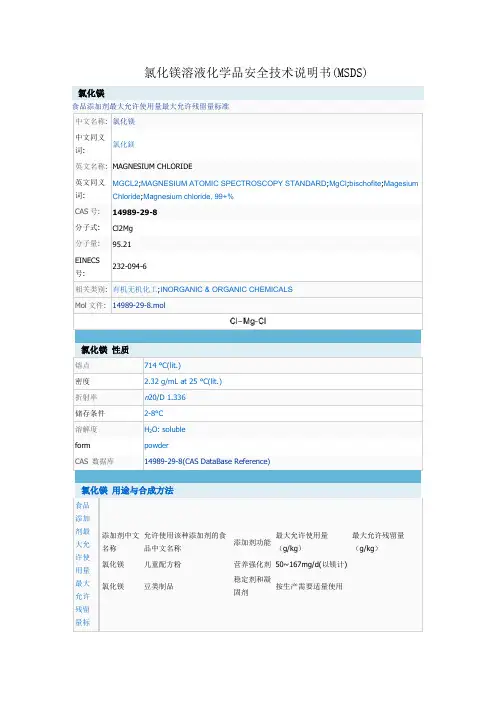
氯化镁溶液化学品安全技术说明书(MSDS) 氯化镁食品添加剂最大允许使用量最大允许残留量标准中文名称: 氯化镁中文同义词:氯化鎂英文名称: MAGNESIUM CHLORIDE英文同义词: MGCL2;MAGNESIUM ATOMIC SPECTROSCOPY STANDARD;MgCl;bischofite;Magesium Chloride;Magnesium chloride, 99+%CAS号: 14989-29-8分子式: Cl2Mg分子量: 95.21EINECS号:232-094-6相关类别: 有机无机化工;INORGANIC & ORGANIC CHEMICALS Mol文件: 14989-29-8.mol氯化镁性质熔点714 °C(lit.)密度 2.32 g/mL at 25 °C(lit.)折射率n20/D 1.336储存条件2-8°C溶解度H2O: solubleform powderCAS 数据库14989-29-8(CAS DataBase Reference)氯化镁用途与合成方法食品添加剂最大允许使用量最大允许残留量标添加剂中文名称允许使用该种添加剂的食品中文名称添加剂功能最大允许使用量(g/kg)最大允许残留量(g/kg)氯化镁儿童配方粉营养强化剂50~167mg/d(以镁计)氯化镁豆类制品稳定剂和凝固剂按生产需要适量使用第一部分:化学品名称化学品中文名称:氯化镁溶液化学品英文名称:magnesium chloride liquid中文别名:英文别名:技术说明书编码:分子式:MgCl2分子量:第二部分:成分/组成信息主要成分及含量:MgCl2 32.0%以上CAS No.:7786-30-314989-29-8是正确的第三部分:危险性概述危险性类别:侵入途径:健康危害:误服有导泻作用。
若肾功能有障碍可出现镁中毒,表现为胃痛、呕吐、水泻、无力和虚脱、呼吸困难、紫绀等。
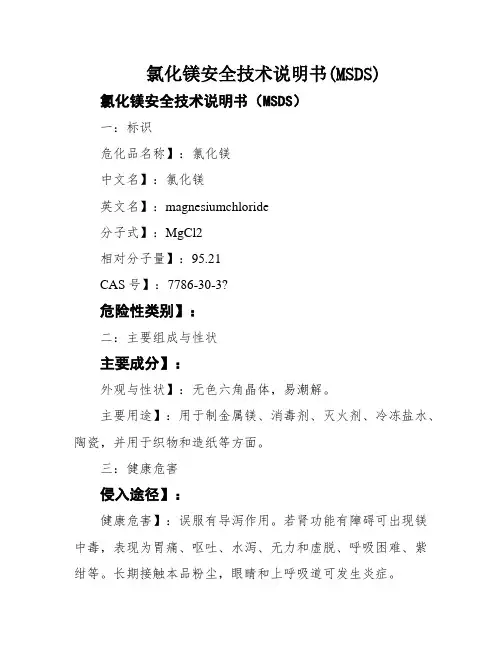
氯化镁安全技术说明书(MSDS)氯化镁安全技术说明书(MSDS)一:标识危化品名称】:氯化镁中文名】:氯化镁英文名】:magnesiumchloride分子式】:MgCl2相对分子量】:95.21CAS号】:7786-30-3?危险性类别】:二:主要组成与性状主要成分】:外观与性状】:无色六角晶体,易潮解。
主要用途】:用于制金属镁、消毒剂、灭火剂、冷冻盐水、陶瓷,并用于织物和造纸等方面。
三:健康危害侵入途径】:健康危害】:误服有导泻作用。
若肾功能有障碍可出现镁中毒,表现为胃痛、呕吐、水泻、无力和虚脱、呼吸困难、紫绀等。
长期接触本品粉尘,眼睛和上呼吸道可发生炎症。
四:急救措施皮肤接触】:脱去污染的衣着,用大量流动清水冲洗。
眼睛接触】:提起眼睑,用流动清水或生理盐水冲洗。
就医。
吸入】:迅速脱离现场至空气新鲜处。
保持呼吸道通畅。
如呼吸困难,给输氧。
如呼吸停止,立即进行人工呼吸。
就医。
食入】:饮足量温水,催吐。
就医。
五:燃爆特性与消防闪点】:无意义燃爆下限】:无意义引燃温度】:无意义爆炸上限】:无意义风险特性】:本身不能燃烧。
受高热分束缚出有毒的气体。
灭火方法】:尽可能将从火场移至空旷处。
切勿将水流直接射至熔融物,以免引起严重的流淌火灾或引起剧烈的沸溅。
灭火剂:雾状水、泡沫、干粉、二氧化碳、砂土。
六:泄露应急处理泄漏应急处理】:隔离泄漏污染区,限制出入。
建议应急处理人员戴防尘口罩,穿一般作业工作服。
不要直接接触泄漏物。
小量泄漏:避免扬尘,小心扫起,置于袋中转移至安全场所。
大量泄漏:收集回收或运至废物处理场所处置。
七:储运注意事项储运注意事项】:储存于阴凉、干燥、透风良好的库房。
远离火种、热源。
防止阳光直射。
包装密封。
应与氧化剂等分开寄存,切忌混储。
储区应备有符合的资料收容泄露物。
八:防护措施中国MAC】:未制定标准前苏联MAC】:未制定标准检测方法】:火焰原子吸收光谱法;达旦黄比色法工程控制】:生产过程密闭,全面通风。
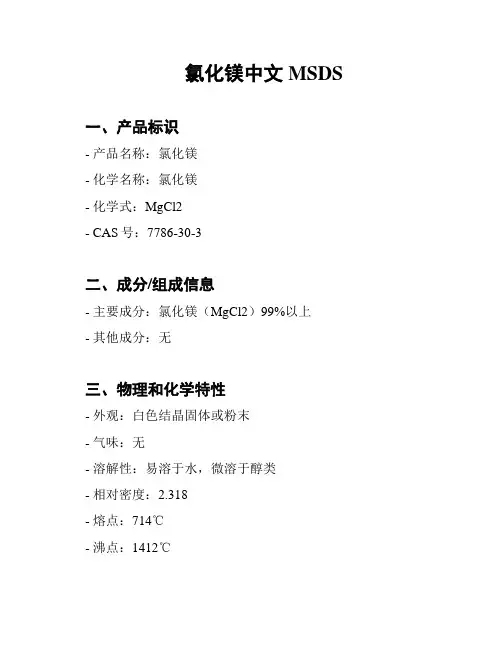
氯化镁中文MSDS一、产品标识- 产品名称:氯化镁- 化学名称:氯化镁- 化学式:MgCl2- CAS号:7786-30-3二、成分/组成信息- 主要成分:氯化镁(MgCl2)99%以上- 其他成分:无三、物理和化学特性- 外观:白色结晶固体或粉末- 气味:无- 溶解性:易溶于水,微溶于醇类- 相对密度:2.318- 熔点:714℃- 沸点:1412℃四、急救措施- 吸入:将患者移至新鲜空气处休息,并在医生的指导下进行治疗。
- 眼部接触:立即用大量清水冲洗至少15分钟。
如果症状持续,请寻求医生帮助。
- 皮肤接触:立即用大量清水冲洗至少15分钟。
如有红肿或发痒等不适,请就医治疗。
- 摄入:不要诱导呕吐,立即咨询医生帮助。
五、消防措施- 灭火剂:干粉、二氧化碳、泡沫- 防护措施:远离火源,戴呼吸器和防护服。
切勿直接用水冲洗火源。
六、泄漏应急处理- 隔离区域:远离火源。
设置非产生火花的通风系统。
- 个人防护:佩戴防护眼镜、呼吸器和防护服。
- 清理方法:用干净的工具或专用压缩空气吸收溢出物质,避免扬散。
- 废弃物处理:处理成为无害产品,按当地法规处置。
七、安全措施- 储存条件:储存于干燥、阴凉、通风良好的地方。
- 操作注意事项:避免吸入尘埃和与皮肤接触。
使用过程中,请勿进食、饮水或吸烟。
- 个人防护措施:佩戴合适的防护眼镜、呼吸器和防护服。
以上信息仅供参考,请遵循当地相关法规和适用要求。
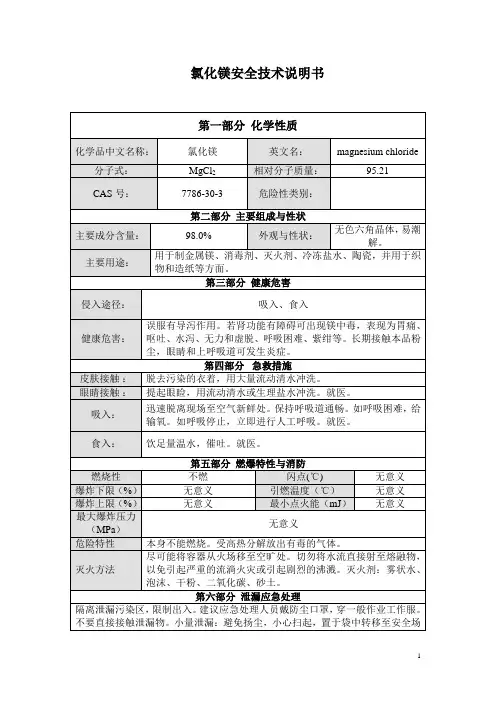

叔丁基氯化镁安全技术说明书叔丁基氯化镁(Butyl magnesium chloride)是一种有机镁化合物,常用于有机合成和聚合反应的催化剂。
由于其具有活泼的化学性质,因此需要采取适当的安全措施来处理和使用。
叔丁基氯化镁的安全技术说明书应包括以下内容:1. 化学品名称及标识叔丁基氯化镁别名:Butyl magnesium chloride分子式:(C4H9)MgCl分子量:CAS号:危险性类别:易燃、易爆、有毒2. 危险性概述叔丁基氯化镁是一种活泼的有机镁化合物,遇水或空气中的湿气会发生剧烈反应,释放出大量热量和易燃的气体。
因此,处理叔丁基氯化镁时应格外小心,并采取适当的安全措施。
3. 健康危害叔丁基氯化镁对皮肤、眼睛和呼吸道有刺激作用。
长时间接触或吸入可能导致头痛、恶心、呕吐、呼吸困难等症状。
大量吸入或摄入可能导致窒息、昏迷和死亡。
4. 急救措施若发生意外接触,应立即用大量清水冲洗皮肤和眼睛,脱去污染的衣物,并立即就医。
若发生吸入或摄入,应立即将受害者移至安全区域,保持呼吸道通畅,并立即就医。
5. 消防措施由于叔丁基氯化镁易燃,因此应使用干粉灭火器或二氧化碳灭火器进行灭火。
在处理叔丁基氯化镁时应远离火源和高温区域。
6. 泄漏处理若发生泄漏,应迅速撤离泄漏区域,并进行隔离和警戒。
使用适当的吸收剂(如沙子)吸收泄漏物,并将其放入适当的容器中。
然后按照废弃物处理规定进行处理。
7. 储存和运输叔丁基氯化镁应储存在干燥、阴凉、通风良好的地方,远离火源和高温区域。
在运输过程中应采取适当的防护措施,如使用防爆运输工具和容器。
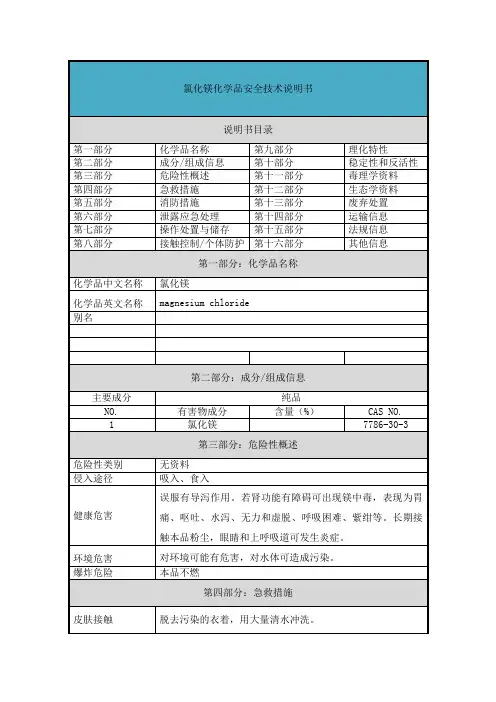


SAFETY DATA SHEETSAccording to Globally Harmonized System of Classification andLabelling of Chemicals (GHS) - Sixth revised edition1.Identification1.1GHS Product identifierProduct name magnesium dichloride hexahydrate1.2Other means of identificationProduct number-Other names Magnesium chloride hexahydrate1.3Recommended use of the chemical and restrictions on useIdentified uses For industry use only.Uses advised against no data available1.4Supplier's detailsCompanyAddressTelephoneFax1.5Emergency phone numberEmergency phone numberService hours Monday to Friday, 9am-5pm (Standard time zone: UTC/GMThours).2.1Classification of the substance or mixtureNot classified.2.2GHS label elements, including precautionary statementsPictogram(s)No symbol.Signal word No signal word.Hazard statement(s)nonePrecautionarystatement(s)Prevention noneResponse noneStorage noneDisposal none2.3Other hazards which do not result in classificationnone3.1Substances4.1Description of necessary first-aid measuresGeneral adviceConsult a physician. Show this safety data sheet to the doctor in attendance.If inhaledIf breathed in, move person into fresh air. If not breathing, give artificial respiration. Consult a physician.In case of skin contactWash off with soap and plenty of water. Consult a physician.In case of eye contactRinse thoroughly with plenty of water for at least 15 minutes and consult a physician.If swallowedNever give anything by mouth to an unconscious person. Rinse mouth with water. Consult aphysician.4.2Most important symptoms/effects, acute and delayedno data available4.3Indication of immediate medical attention and special treatment needed, if necessaryno data available5.1Extinguishing mediaSuitable extinguishing mediaUse water spray, alcohol-resistant foam, dry chemical or carbon dioxide.5.2Specific hazards arising from the chemicalno data available5.3Special protective actions for fire-fightersWear self-contained breathing apparatus for firefighting if necessary.6.1Personal precautions, protective equipment and emergency proceduresUse personal protective equipment. Avoid dust formation. Avoid breathing vapours, mist or gas.Ensure adequate ventilation. Evacuate personnel to safe areas. Avoid breathing dust. Forpersonal protection see section 8.6.2Environmental precautionsPrevent further leakage or spillage if safe to do so. Do not let product enter drains. Dischargeinto the environment must be avoided.6.3Methods and materials for containment and cleaning upPick up and arrange disposal. Sweep up and shovel. Keep in suitable, closed containers fordisposal.7.1Precautions for safe handlingAvoid contact with skin and eyes. Avoid formation of dust and aerosols. Avoid exposure -obtain special instructions before use.Provide appropriate exhaust ventilation at places wheredust is formed. For precautions see section 2.2.7.2Conditions for safe storage, including any incompatibilitiesStore in cool place. Keep container tightly closed in a dry and well-ventilated place.8.1Control parametersOccupational Exposure limit valuesno data availableBiological limit valuesno data available8.2Appropriate engineering controlsHandle in accordance with good industrial hygiene and safety practice. Wash hands beforebreaks and at the end of workday.8.3Individual protection measures, such as personal protective equipment (PPE)Eye/face protectionSafety glasses with side-shields conforming to EN166. Use equipment for eye protection testedand approved under appropriate government standards such as NIOSH (US) or EN 166(EU).Skin protectionWear impervious clothing. The type of protective equipment must be selected according to theconcentration and amount of the dangerous substance at the specific workplace. Handle withgloves. Gloves must be inspected prior to use. Use proper glove removal technique(withouttouching glove's outer surface) to avoid skin contact with this product. Dispose of contaminatedgloves after use in accordance with applicable laws and good laboratory practices. Wash anddry hands. The selected protective gloves have to satisfy the specifications of EU Directive89/686/EEC and the standard EN 374 derived from it.Respiratory protectionWear dust mask when handling large quantities.Thermal hazardsno data availablePhysical state white to brown flake or granular crystal Colour no data availableOdour no data available117ºCMelting point/ freezingpoint1412ºCBoiling point or initialboiling point and boilingrangeFlammability no data availableno data availableLower and upper explosionlimit / flammabilitylimitFlash point no data availableno data availableAuto-ignitiontemperatureDecompositionno data availabletemperaturepH no data availableKinematic viscosity no data availableSolubility In water:2350 g/L (20 ºC)no data availablePartition coefficientn-octanol/water (logvalue)Vapour pressure no data available1.569Density and/or relativedensityRelative vapour density no data availableParticle characteristics n o data available10.1Reactivityno data available10.2Chemical stabilityStable under recommended storage conditions.10.3Possibility of hazardous reactionsno data available10.4Conditions to avoidno data available10.5Incompatible materialsno data available10.6Hazardous decomposition productsno data availableAcute toxicity•Oral: no data available•Inhalation: no data available•Dermal: no data availableSkin corrosion/irritationno data availableSerious eye damage/irritationno data availableRespiratory or skin sensitizationno data availableGerm cell mutagenicityno data availableCarcinogenicityno data availableReproductive toxicityno data availableSTOT-single exposureno data availableSTOT-repeated exposureno data availableAspiration hazardno data available12.1Toxicity•Toxicity to fish: no data available•Toxicity to daphnia and other aquatic invertebrates: no data available •Toxicity to algae: no data available•Toxicity to microorganisms: no data available12.2Persistence and degradabilityno data available12.3Bioaccumulative potentialno data available12.4Mobility in soilno data available12.5Other adverse effectsno data available13.1Disposal methodsProductThe material can be disposed of by removal to a licensed chemical destruction plant or bycontrolled incineration with flue gas scrubbing. Do not contaminate water, foodstuffs, feed orseed by storage or disposal. Do not discharge to sewer systems.Contaminated packagingContainers can be triply rinsed (or equivalent) and offered for recycling or reconditioning.Alternatively, the packaging can be punctured to make it unusable for other purposes and thenbe disposed of in a sanitary landfill. Controlled incineration with flue gas scrubbing is possiblefor combustible packaging materials.14.1UN NumberADR/RID: Not dangerous goods.I MDG: Not dangerous goods.I ATA: Not dangerous good 14.2UN Proper Shipping NameADR/RID: unknownIMDG: unknownIATA: unknown14.3Transport hazard class(es)ADR/RID: Not dangerous goods.I MDG: Not dangerous goods.I ATA: Not dangerous good 14.4Packing group, if applicableADR/RID: Not dangerous goods.I MDG: Not dangerous goods.I ATA: Not dangerous good 14.5Environmental hazardsADR/RID: no IMDG: no IATA: no14.6Special precautions for userno data available14.7Transport in bulk according to Annex II of MARPOL 73/78 andthe IBC Codeno data available15.1Safety, health and environmental regulations specific for theproduct in question。
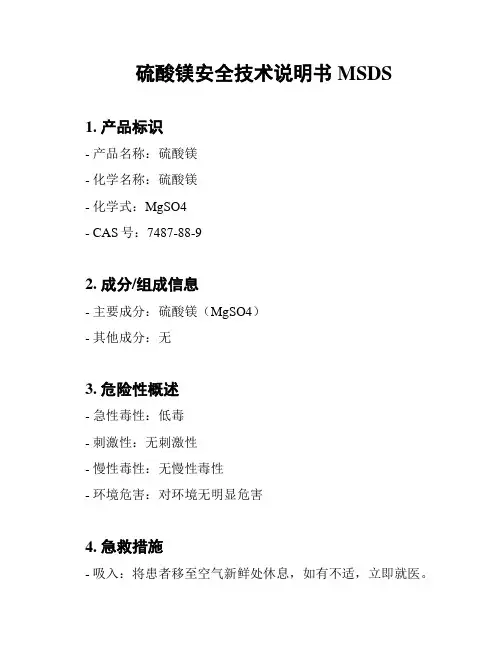
硫酸镁安全技术说明书MSDS1. 产品标识- 产品名称:硫酸镁- 化学名称:硫酸镁- 化学式:MgSO4- CAS号:7487-88-92. 成分/组成信息- 主要成分:硫酸镁(MgSO4)- 其他成分:无3. 危险性概述- 急性毒性:低毒- 刺激性:无刺激性- 慢性毒性:无慢性毒性- 环境危害:对环境无明显危害4. 急救措施- 吸入:将患者移至空气新鲜处休息,如有不适,立即就医。
- 眼部接触:立即冲洗受影响的眼睛,持续冲洗15分钟,并及时就医。
- 皮肤接触:立即用大量水冲洗受影响的皮肤区域,如有不适,就医。
- 摄入:立即给患者大量饮水,不要催吐,立即就医。
5. 消防措施- 燃烧特性:硫酸镁不易燃烧。
- 灭火方法:可用水、二氧化碳、泡沫和干粉进行灭火。
避免使用直接水流。
- 避免的灭火剂:避免使用油类灭火剂。
6. 泄漏应急处理- 个人防护措施:佩戴防护眼镜、手套和防护服。
- 环境防护措施:避免将硫酸镁泄漏物排入水源或下水道。
- 泄漏清理方法:用干燥的工具将硫酸镁收集,并转移到密闭容器中,然后用大量水冲洗受影响的区域。
7. 储存和运输- 储存要求:储存在干燥、通风的地方,避免阳光直射。
- 包装要求:使用耐酸碱的密封容器进行包装。
- 运输注意事项:避免与酸、碱、氧化剂等混合运输。
8. 操作注意事项和个人防护- 操作注意事项:避免与酸、碱等物质接触。
- 个人防护装备:戴防护眼镜、手套和防护服。
9. 法规信息- 法规依据:符合国家相关法规。
10. 稳定性和反应活性- 稳定性:稳定。
- 可燃性:不可燃。
- 避免的条件:避免与酸、碱等物质接触。
11. 毒理学信息- 急性毒性:LD50(大鼠经口)为5000 mg/kg。
- 致敏性:无致敏性。
12. 生态学信息- 环境影响:对环境无明显危害。
13. 废弃物处理- 废弃物处理方法:按照当地法规进行处理。
14. 运输信息- 运输分类:非危险品。
- 包装标志:无。
- 包装方法:按照运输规定进行包装。
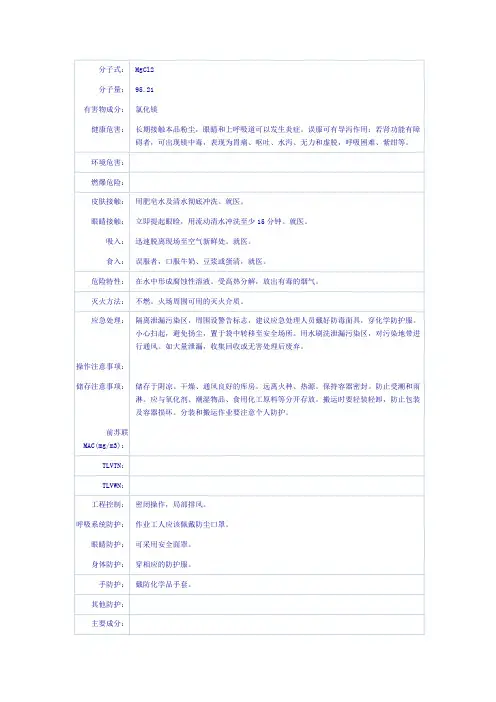
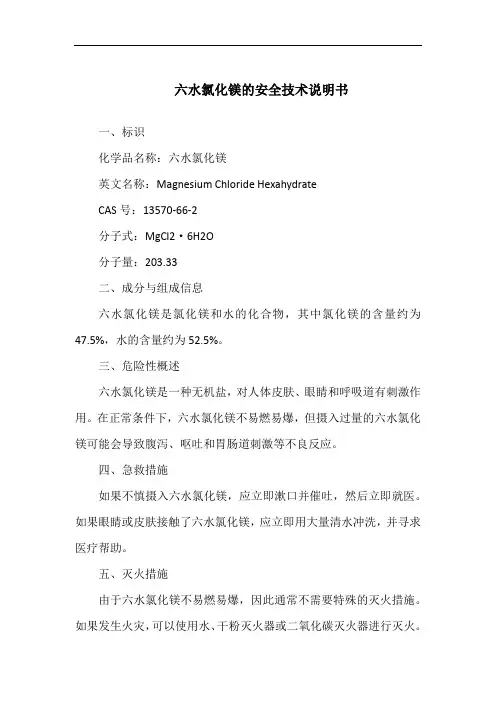
六水氯化镁的安全技术说明书
一、标识
化学品名称:六水氯化镁
英文名称:Magnesium Chloride Hexahydrate
CAS号:13570-66-2
分子式:MgCl2·6H2O
分子量:203.33
二、成分与组成信息
六水氯化镁是氯化镁和水的化合物,其中氯化镁的含量约为
47.5%,水的含量约为52.5%。
三、危险性概述
六水氯化镁是一种无机盐,对人体皮肤、眼睛和呼吸道有刺激作用。
在正常条件下,六水氯化镁不易燃易爆,但摄入过量的六水氯化镁可能会导致腹泻、呕吐和胃肠道刺激等不良反应。
四、急救措施
如果不慎摄入六水氯化镁,应立即漱口并催吐,然后立即就医。
如果眼睛或皮肤接触了六水氯化镁,应立即用大量清水冲洗,并寻求医疗帮助。
五、灭火措施
由于六水氯化镁不易燃易爆,因此通常不需要特殊的灭火措施。
如果发生火灾,可以使用水、干粉灭火器或二氧化碳灭火器进行灭火。
六、储存和操作
六水氯化镁应储存在干燥、阴凉的地方,远离热源和火源。
在操作过程中,应佩戴个人防护装备,如化学防护眼镜、化学防护手套和实验服等。
七、泄漏应急处理
如果六水氯化镁发生泄漏,应立即采取措施防止其进入土壤或水源,并立即清理泄漏物。
在清理泄漏物时,应佩戴适当的个人防护装备,并使用适当的清洁剂或吸收剂。
xx市xx矿业有限公司氯化镁阻化剂安全性和环保性评估报告xx矿业有限公司根据《煤矿安全规程》第二百五十九条矿井防灭火使用的凝胶、阻化剂及进行充填、堵漏、加固用的高分子材料,在使用前应当对其安全性和环保性进行评估,为了安全生产特编制本报告。
一、依据技术指标:QB/T2605-2003、氯化镁产品说明书、氯化镁安全技术说明书。
二、评估的内容:(一)、原材料及混成料对人体的危害,混成过程及喷、注过程产生的有害气体对人体的危害,控制及防护措施。
1、原材料及混成料对人体的危害:本煤矿选用氯化镁作为阻化剂,分子式(ΜgCl2)、形状(片状分子),熔点为714℃,沸点为1412℃,氯化镁纯品为无色单斜结晶,工业品通常呈黄褐色,有苦咸味,容易吸湿潮解,常温下其水溶液呈中性。
氯化镁原材料及混成料误服有导泻作用,若肾功能有障碍可出现镁中毒,表现为胃痛、呕吐、水泻、无力和虚脱、呼吸困难、紫绀等。
长期接触本品粉尘,眼睛和上呼吸道可发生炎症。
2、混成过程及喷注过程产生的有害气体对人体的危害:根据氯化镁安全技术说明书得知氯化镁(卤片)易溶于水和乙醇,0℃时溶于冷水,在湿度较大时,容易潮解,溶解或潮解过程中沸点范围小于64.8℃,混成及喷注过程中不产生有毒有害气体。
3、控制及防护措施:吸入、食入、眼睛接触和皮肤接触是氯化镁对身体造成危害的常见情况。
如吸入应迅速脱离现场至空气新鲜处,保持呼吸道通畅,如呼吸困难给氧气,如呼吸停止,立即进行人工呼吸,就医。
如食入应饮足温水催吐,就医。
如眼镜接触应提起眼睑,用流动清水冲洗,就医。
如皮肤接触应立即脱去污染的衣着,用大量流动清水冲洗。
操作人员必须经过专门培训,严格遵守操作规程,皮肤防护要求操作人员必须佩戴自吸过滤式防尘口罩,眼镜防护戴化学安全防护眼镜,手部防护戴防化学品手套,皮肤及身体防护穿橡胶耐酸碱服。
卫生措施要求操作时不得进食、饮水、工作完毕,彻底清洗,保持良好的卫生习惯。
(二)、混材料及混成料对设备腐蚀危险性及防范措施:氯化镁水溶液常温下呈弱酸性对金属有一定的腐蚀性,在实际应用过程中喷嘴低垂,喷洒大脚前底板浮煤时喷嘴离底板高度不大于0.2m尽量避免混成料与支柱等金属物接触,每次操作完毕后,对受影响的支柱用清水冲洗干净。
化学品安全技术说明书(MSDS)第一部分:化学品名称1.1 化学品中文名称:1.2 化学品英文名称:1.3中文名称2:1.4 分子式:1.5 分子量:第二部分:成分/组成信息2.1 主要成分:2.2 含量:2.3 CAS No.第三部分:危险性概述3.1 危险性类别:3.2 侵入途径:3.3 健康危害:第四部分:急救措施4.1 皮肤接触:4.2 眼睛接触:4.3 吸入:4.4 食入:第五部分:消防措施5.1 危险特性:5.2 有害燃烧产物:5.3 灭火方法:第六部分:泄漏应急处理6.1 应急处理:第七部分:操作处置与储存7.1 操作注意事项:7.2 储存注意事项:第八部分:接触控制/个体防护8.1 职业接触限值:8.2 监测方法:8.3 工程控制:8.4 呼吸系统防护:8.5 眼睛防护:8.6 身体防护:8.7 手防护:8.8 其他防护:第九部分:理化特性9.1 外观与性状:9.2 熔点(°C):9.3 沸点(°C):9.4 液碱相对密度:9.5 蒸气密度(空气=1):9.6 饱和蒸气压(kPa):9.7 燃烧热(kJ/mol):9.8 临界温度(°C):9.9 临界压力(MPa):9.10 辛醇/水分配系数:9.11 引燃温度(°C):9.12 闪点(°C):9.13 爆炸上限%(V/V):9.14 爆炸下限%(V/V):9.15 溶解性:9.16主要用途:第十部分:稳定性和反应活性10.1 稳定性:10.2 禁忌物:10.3 避免接触的条件:10.4 聚合危害:10.5 分解产物:第十一部分:毒理学资料11.1 急性毒性:11.2 亚急性和慢性毒性:11.3 刺激性:第十二部分:生态学资料12.1 生态毒理毒性:12.2 生物降解性:12.3 非生物降解性:12.4 生物富集或生物积累性:12.5 其它有害作用:第十三部分:废弃处置13.1废弃物性质:13.2废弃处置方法:13.3废弃注意事项:第十四部分:运输信息14.1 危险货物编号:14.2 UN编号:14.3 包装标志:14.4 包装类别:14.5 包装方法:14.6 运输注意事项:第十五部分:法规信息法规信息:第十六部分:其他信息16.1参考文献:16.2其他信息:。
镁MSDS 新版化学品安全技术说明书化学品安全技术说明书修改日期:产品名称:镁MSDS编号:版本:1.0第一部分:化学品及企业标识化学品中文名:镁化学品英文名:magnesiumCAS No。
7439-95-4EC No。
231-104-6分子式:Mg分子量:24.31g/mol企业名称:企业地址:邮编:传真:联系电子邮件地址:企业应急第二部分:危险性概述紧急情况概述:镁是固体,易燃。
其粉末与空气混合能形成爆炸性混合物。
在空气中容易发生自热反应,有引发火灾的危险。
与水接触会生成高度易燃气体。
危险性类别(GB-2013):自热物质和混合物,类别1(粉末);遇水放出易燃气体的物质和混合物,类别2;易燃固体,类别2.标签要素(GB-2013):警示词:危险危险信息:易燃固体;自热,可能燃烧;遇水放出易燃性气体。
防范说明:远离热源、火花、明火和热表面,严禁吸烟。
不得与空气和水接触,在惰性气体中操作。
避免产生扬尘。
佩戴防护手套、防护眼罩和防护面具,穿防护服。
事故响应:如皮肤沾染,掸掉皮肤上的细小颗粒。
浸入冷水中或用湿绷带包扎。
火灾时使用干砂、干粉灭火。
安全存储:存放于干燥处。
存放于密闭的中。
内装物存放于惰性气体中。
废弃处置:本品及的处置应遵循地方/国家法规规定。
第三部分:成分/组成信息成分:镁含量:99%XXX:7439-95-4第四部分:急救措施皮肤接触:立即脱去污染的衣着,用大量流动肥皂水和清水冲洗,如有不适,就医。
眼睛接触:提起眼睑,用清水冲洗,如有不适,就医。
吸入:迅速脱离现场至空气新鲜处,保持呼吸道通畅,如呼吸困难,给输氧。
如呼吸停止,立即进行心肺复苏术,就医。
食入:禁止催吐,切勿给失去知觉者从嘴里喂食任何东西,就医。
对保护施救者的忠告:泄漏物质如果被水污染,可能会产生易燃气体。
因此,必须在有排风的内收容泄漏物,并尽快废弃处理。
在清除所有火源的同时,要增强通风,避免接触皮肤和眼睛,并使用防护装备,包括呼吸面具。
化学品安全技术说明书第1部分化学品及企业标识化学品中文名:六水氯化镁化学品英文名:magnesium dichloride hexahydrate企业名称:此处填写贵公司名称企业地址:此处填写贵公司地址传真:此处填写贵公司传真联系电话:此处填写贵公司电话企业应急电话:此处填写贵公司应急电话产品推荐及限制用途:For industry use only.。
第2部分危险性概述紧急情况概述:无资料GHS危险性类别:无危害分类标签要素:象形图:无危险图标警示词:无警示词。
危险性说明:无防范说明:•预防措施:•无•事故响应:•无•安全储存:•无•废弃处置:•无物理和化学危险:无资料健康危害:无资料环境危害:无资料第3部分成分/组成信息第4部分急救措施急救:吸入: 如果吸入,请将患者移到新鲜空气处。
皮肤接触: 脱去污染的衣着,用肥皂水和清水彻底冲洗皮肤。
如有不适感,就医。
眼晴接触: 分开眼睑,用流动清水或生理盐水冲洗。
立即就医。
食入: 漱口,禁止催吐。
立即就医。
对保护施救者的忠告:将患者转移到安全的场所。
咨询医生。
出示此化学品安全技术说明书给到现场的医生看。
对医生的特别提示:无资料。
第5部分消防措施灭火剂:用水雾、干粉、泡沫或二氧化碳灭火剂灭火。
避免使用直流水灭火,直流水可能导致可燃性液体的飞溅,使火势扩散。
特别危险性:无资料。
灭火注意事项及防护措施:消防人员须佩戴携气式呼吸器,穿全身消防服,在上风向灭火。
尽可能将容器从火场移至空旷处。
处在火场中的容器若已变色或从安全泄压装置中发出声音,必须马上撤离。
隔离事故现场,禁止无关人员进入。
收容和处理消防水,防止污染环境。
第6部分泄露应急处理作业人员防护措施、防护装备和应急处置程序:建议应急处理人员戴携气式呼吸器,穿防静电服,戴橡胶耐油手套。
禁止接触或跨越泄漏物。
作业时使用的所有设备应接地。
尽可能切断泄漏源。
消除所有点火源。
根据液体流动、蒸汽或粉尘扩散的影响区域划定警戒区,无关人员从侧风、上风向撤离至安全区。
一、理化特性:二、危险性概述:1、危险性类别:对环境可能有危害,对水体可造成污染。
2、G HS-分类:非危险物质或混合物。
3、图标或危害标志:无资料4、危险信息:误服有导泻作用。
若肾功能有障碍可出现镁中毒,表现为胃痛、呕吐、水泻、无力和虚脱、呼吸困难、紫绀等。
长期接触本品粉尘,眼睛和上呼吸道可发生炎症。
5、预防措施:不要吸入粉尘/烟/气体/烟雾/蒸气/喷雾。
作业后彻底清洗。
使用本产品时不要进食、饮水或吸烟。
只能在室外或通风良好之处使用。
戴防护手套/穿防护服/戴防护眼罩/戴防护面具。
三、急救措施1、皮肤接触:脱去污染的衣着,用大量流动清水冲洗。
2、眼睛接触:提起眼睑,用流动清水或生理盐水冲洗。
就医。
3、吸入:迅速脱离现场至空气新鲜处。
保持呼吸道通畅。
如呼吸困难,给输氧。
如呼吸停止,立即进行人工呼吸。
就医。
4、食入:饮足量温水,催吐。
就医。
四、消防措施1、危险特性:本身不能燃烧。
受高热分解放出有毒的气体。
2、灭火方法与灭火剂:尽可能将容器从火场移至空旷处。
切勿将水流直接射至熔融物,以免引起严重的流淌火灾或引起剧烈的沸溅。
灭火剂:水雾,耐醇泡沫,干粉或二氧化碳。
3、灭火注意事项及措施:灭火时,应佩戴呼吸面具((符合MSHA/NIOSH 要求的或相当的))并穿上全身防护服。
在安全距离处、有充足防护的情况下灭火。
防止消防水污染地表和地下水系统。
五、泄漏应急措施1、作业人员防护措施:保证充分的通风。
清除所有点火源。
迅速将人员撤离到安全区域,远离泄露区域并处于上风方向。
使用个人防护装备。
避免吸入蒸气、烟雾、气体或风尘。
2、泄漏化学品的收容、清除方法及处置材料:扫掉和铲掉。
放入合适的封闭的容器中待处理。
六、操作处置与储存1、操作注意事项:在有粉尘生成的地方,提供合适的排风设备。
2、储存注意事项:储存于阴凉、干燥、通风良好的库房。
远离火种、热源。
防止阳光直射。
包装密封。
应与氧化剂等分开存放,切忌混储。
储区应备有合适的材料收容泄漏物。